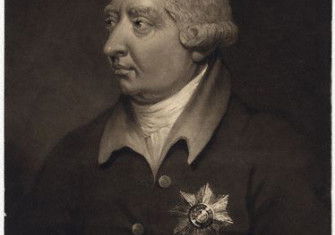The History of ‘God Save the King’
Charles Dimont traces the origin and history of ‘God Save the King’ (or ‘God Save the Queen’), the British national anthem.

The origins of “God Save the Queen” are lost in obscurity, but there is no doubt whatever that the words and the tune, as we know them today, suddenly became widely popular in September, 1745. In that month, demonstrations of loyalty to the reigning house were in special demand. Charles Edward, the Young Pretender, had routed Cope at Prestonpans, and was about to invade England; London was preparing to defend itself and its Hanoverian rulers. An example of popular feeling was given on September 28th when the entire male caste of Drury Lane theatre announced their intention of forming a special unit of the Volunteer Defence Force. That evening they gave a performance of Jonson’s The Alchemist. At its conclusion there was an additional item. Three of the leading singers of the day—Mrs. Cibber, Beard and Reinhold —stepped forward and began a special anthem:
“God bless our Noble King,
God Save great George our King ...”
The Daily Advertiser reported: “The universal applause sufficiently denoted in how just an Abhorrence they (the audience) hold the Arbitrary Schemes of our invidious enemies. ...” The other theatres were quick to follow Drury Lane. Benjamin Victor, the linen merchant, wrote to his friend Garrick, who was ill in the country: “The stage is the most loyal place in the three kingdoms,” and Mrs. Cibber noted: “The Rebellion so far from being a disadvantage to the playhouses, brings them very good houses.” Soon the anthem was being sung as far afield as Bath.
Neither words nor music were new. They had been published in 1744 in the Thesaurus Musicus. Dr. Thomas Arne compiled Drury Lane’s version in September 1745, and one of his younger pupils, Charles Burney, produced the setting for Covent Garden. Sixty years later, the eminent Dr. Burney recalled some interesting facts about the origins of the anthem for the benefit of his friend Sir Joseph Banks, the naturalist. Burney, in common with all contemporaries dealing with the 1745 versions, referred to an “old tune” and an “old anthem.” He continued:
“Old Mrs. Arne, the mother of Dr. Arne and Mrs. Cibber, a bigotted Roman Catholic, said she had heard it sung not only at the playhouse but in the street when the Prince of Orange was hovering over the coast.”
On a later occasion Burney was more definite:
“the earliest copy of the words we are acquainted with begin—God Save Great James Our King. I asked Dr. Arne if he knew who the composer was: he said he had not the least knowledge ... but that it was a received opinion that it was written and composed for the Catholic Chapel of James II.”
This is not unlikely. Musicians trace the origins of the melody from a medieval plainsong chant and on, through a carol, to a tune by the Elizabethan, John Bull. At the end of the seventeenth century, Purcell wrote a few bars which are almost identical with the opening phrases of the Arne and Burney versions. There is not a shred of reliable evidence that either Henry Carey or the French composer, Lully, had a hand in the music.
The words contain such an obvious sentiment of loyalty that it is impossible to give any precise date for their origin. The phrase “God Save the King” occurs in several places in the earliest English translations of the Bible. An Order of the Fleet at Portsmouth for August 10th, 1544, laid down the watchword for the day as “God Save King Henry” and the counterword as “Long to Reign Over Us.” From the Accession of Queen Elizabeth, Royal Proclamations end with “God Save the Queen.” Several other ideas in the anthem, such as “Scatter Our Enemies” and “Confound Their Devices” were often employed in loyal prayers of the sixteenth and seventeenth centuries for the Sovereign and the State. It can be safely presumed that by the reign of James II, both words and music of “God Save The King” were known in an accepted form. It is possible—though this can be no more than speculation—that a Latin version, known to have been extant at the beginning of the eighteenth century, was first composed for use in his Catholic chapels. What is certain is that after the Revolution, the anthem was regarded as an expression of loyalty to the Hanoverian dynasty.
It was not yet, of course, the National Anthem. Such a concept would have been incomprehensible to the eighteenth cenutry. But within a year or so of 1745 it was being played and sung whenever Royalty appeared in public. Later in the century, Fanny Burney describes a visit with the Court to Cheltenham:
“All the way upon the road we rarely proceeded five miles without encountering a band of the most horrid fiddlers, scraping “God Save The King,” with all their might, out of time, out of time, and all in the rain ...”
Oddly enough, although it was loyal, it was not yet regarded as sacred music. At Lyndhurst, in 1789, Fanny Burney attended the Parish Church to give thanks for her Monarch’s recovery from one of his bouts of lunacy.
“After the service, instead of the psalm, imagine our surprise to hear the whole congregation join in ‘God Save The King.’ Misplaced as this was in a church, it’s interest was so kind, so loyal and so affectionate, that I believe there was not a dry eye. ...”
Miss Burney has also recorded some of the best-known occasions on which the anthem was played:
“At Weymouth God Save The King is inscribed on the hats and caps of children, all the bargemen wear it in cockades; and even the bathing women have it in large coarse girdles round their waists. The King bathes and with great success; a machine follows the Royal one into the sea filled with fiddlers who play ‘God Save The King’ as His Majesty takes his plunge!”
The anthem was being sung on a May night in the Theatre Royal in 1800 when Hadfield made his unsuccessful attempt on the life of George III. Sheridan improvised a special additional verse on the spur of the moment, expressive of the people’s gratitude for the benign intervention of Providence. But neither under the Regency nor under George IV was “God Save The King” regarded as a sacred melody. It was sung for the first time at a Coronation for the crowning of George IV, though a part of the congregation in the Abbey pointedly sang “God Save The Queen” to show where their sympathies lay in the question of the Royal Divorce.
William IV listened to an odd performance when he and Queen Adelaide opened the new London Bridge in 1831. They dined in the middle of the structure, and during the meal an official glee-party, under Sir George Smart, rendered musical honours, including “God Save The King.” To Smart’s consternation, a man and a woman walked forward,
“he playing ‘God Save The King’ with his knuckles on his chin, accompanied by his wife’s voice. The King called to me and asked me who they were. I told him I was sorry they had intruded without permission. ‘Oh, no. No intrusion ’ said the King. ‘It was charming. Tell them to perform it again.”
After the accession of Queen Victoria it is regularly referred to as the National Anthem, though the Queen seems to have regarded it as a family anthem as well, for special verses were produced for royal births and marriages.
Probably it was in foreign countries that the National Anthem was first included in collections of hymns. It is believed to be the first example of its particular metre in any European language—6.6.4.6.6.6.4. Once it had established itself in popular fancy, it was bound to spread. Numberless hymn-writers employed the metre, and before the eighteenth century was out, suitable national words had been composed for the time in Holland and Denmark, and many German States had adopted for their own Schumacher’s verse beginning “Heil dir im Sieger-kranz.” Russia used the tune until 1833, and Sweden and Liechtenstein are two other states who have set their own words to the music. The Swiss have no National Anthem, but they have written both French and German words to the melody. The American version “My Country ’Tis of Thee” appeared in 1831. Among composers, Haydn was a great admirer of “God Save The King,” and was instructed to compose something on the same lines when commissioned to write the Emperor’s Hymn— better known today in its later form of Deutschland Ueber Alles. Beethoven declared “I must show the English what a blessing they have in ‘God Save The King'. He wrote several variations on the tune and included the theme in his tribute to Wellington, The Battle. Weber used the melody at least twice, and Brahms wove it into his Triumphlied. J. C. Bach and Liszt are among many others who improvised on the anthem.
Since its first popularity in 1745, endless attempts have been made to improve the words. In December of that year the Gentlemen’s Magazine declared “the words have no merit but their loyalty” and offered its own new version, "Fame, let thy trumpet sing.” But the public stuck to Arne and Burney. In these settings there was no ambiguity about one’s loyalty— “Great George,” “On him our hopes are fixed,” “Scatter his enemies,” “May he defend our laws.” With the omission of one stanza referring to Marshal Wade “crushing rebellious Scots',” the 1745 Anthem remains substantially the accepted version today. It is a curious fact that an official version seems never to have been laid down. Longfellow’s improving lines were included in a Jubilee rendering for Queen Victoria:
“Lord, let war’s tempest cease
Fold the whole world in peace
Under thy wings.”
In 1919 a “Peace Version” of the Anthem was approved by the Privy Council and is nowadays included in certain hymnbooks. In 1931 Mr. Philip Snowden, then Chancellor of the Exchequer, declared in the House of Commons: “It may be information to hon. members to know that the words to which the tune is sung are no part of the National Anthem. It is only the tune itself which is the National Anthem.” However this may be, the final and most precise arbiter on the performance of “God Save The Queen” does envisage its being sung to the accepted words. This is the appropriate section of Queen’s Regulations for the Army:
“The authorized arrangement of the National Anthem as published by Messrs. Boosey and Hawkes Ltd. will invariably be used and will be rendered in the following style:
“The first bars will be played pianissimo at M.M. 60 crotchets, using the full reeds, horns and basses ... (the brass will be brought smartly into playing position on the third beat of the fifth bar) ... The comets and the side drum will be added on the second beat of the sixth bar... . The last eight bars will be played fortissimo as broadly as possible... . For singing, the key of ‘F’ will be used.”






